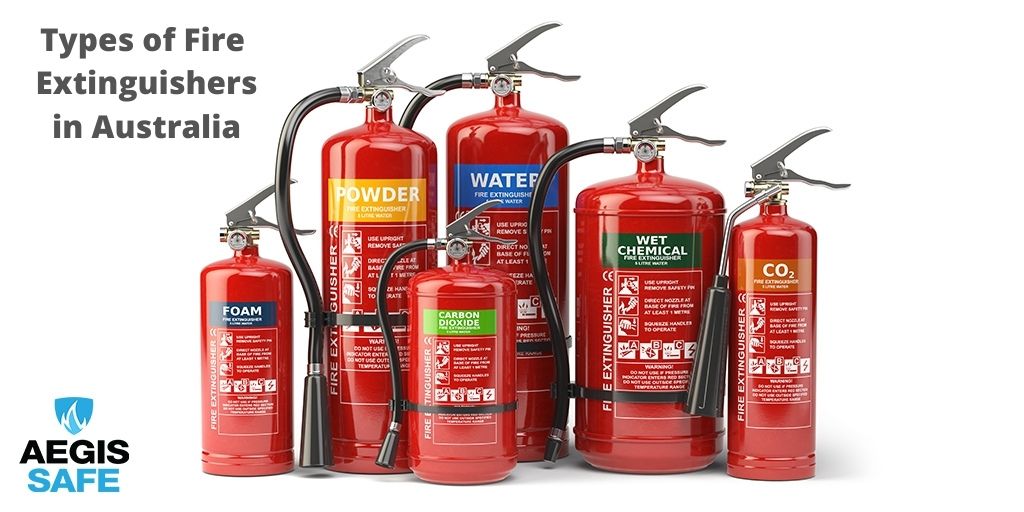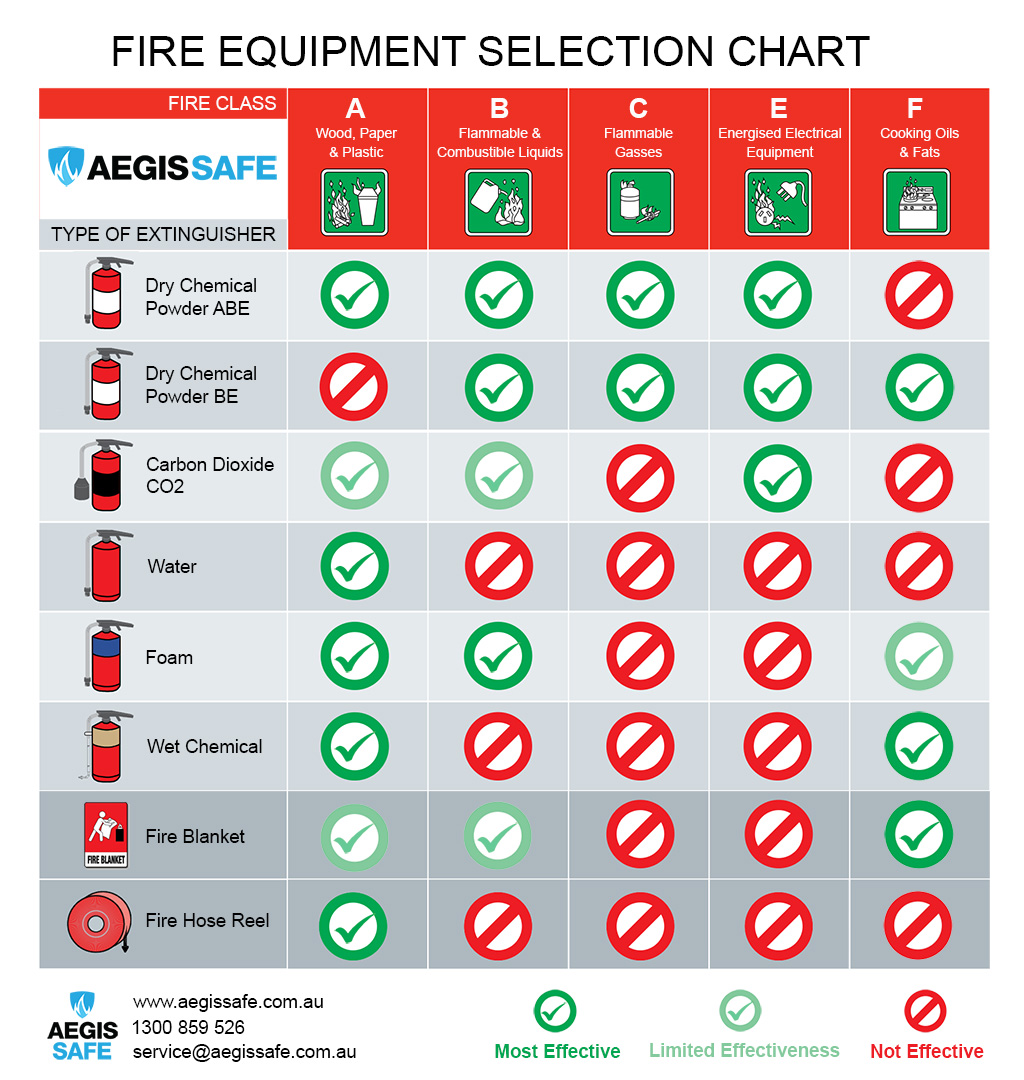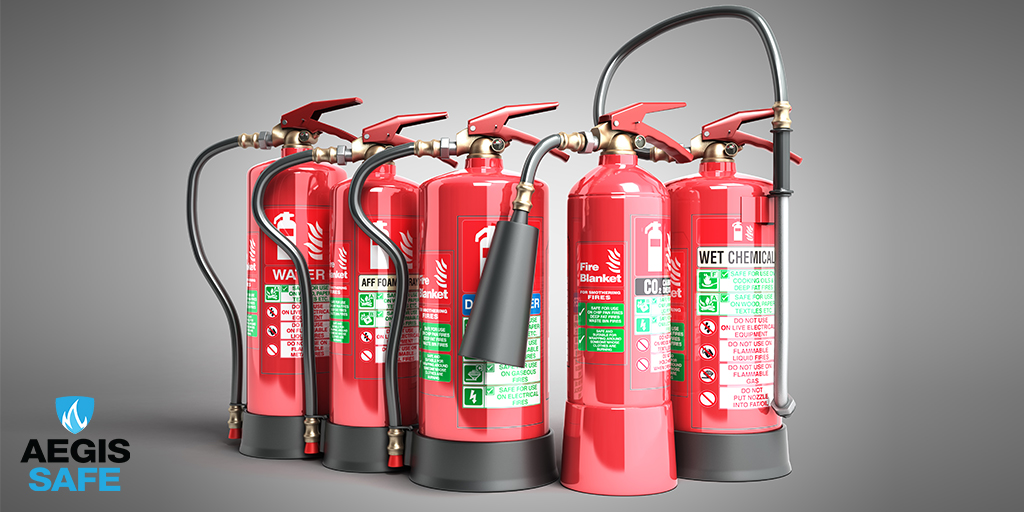Cart
Types of Fire Extinguishers in Australia
Aegis Safe supply a wide range of portable fire extinguishers to suit all types and classes of fires. So if you are looking for high-quality fire extinguisher services at low prices in Brisbane, Gold Coast and Sunshine Coast then contact us today. We are also here to help you with selecting the correct fire extinguishers for installation and fire compliance.
Knowing the exact type of fire extinguisher your business need can be a tricky procedure. You will need to be aware of the type of fire your business is most likely to suffer, as well as the usage of each unique fire extinguisher.
If you are well-informed of the details and have performed an extensive research beforehand, it will go a long way to help you maintain safety in your building. Frequent extinguisher testing coupled with awareness will only benefit your enterprise. You don’t want your employees to question which fire equipment to utilize during an emergency. Each wasted second can be the difference between life and death.
So, make sure to familiarise your employees with each fire extinguisher variant and their usage accordingly. When you eliminate the chances of any emergency, you are aiding them to make the correct choice during a detrimental situation.
Feel free to contact Aegis Safe for more information about fire protection equipment. Our team of experts are extremely adept to advice you about fire extinguisher testing requirements. We are fully equipped to handle your safety obligations and can assist you in preventing any detrimental situation at your workplace.

Dry chemical powder fire extinguishers
The cylinder of the dry powder extinguisher is branded with a white coloured band and comes in types ABE and BE. Each type is specifically designed for multiple fire sources.
For fires fuelled by cooking oils & fats, combustible gases, flammable liquids or any types of electrical fire, the white BE extinguisher is most suitable.
For fires fuelled by combustible gases, flammable liquids, electrical fires, and class A fires (caused by carbonaceous solids like rubber, cloth, paper, wood), the ABE solution is the most potent option in this solution.
A number of different sizes can be observed for the white banded model. For service vans, buses or small kitchens, you can even purchase a 1.5 kg extinguisher. Retail stores, kitchens, garage areas and office areas often make use of 2 kg extinguishers.
4.5 kg and 9 kg dry powder fire extinguishers are more common in areas such as fuel stations, large offices and warehouses. Aegis Safe offers fire extinguisher testing so that you can adequately maintain each device.
Carbon dioxide fire extinguishers
In case of electrical fires, the CO2 extinguishing agent is most suitable for use. A black band is used to mark this variant for ease of identification. However, the ability of the carbon dioxide extinguisher is limited when facing fires originating from other sources.
It’s better to have access to more than one type of fire extinguisher, depending on the associated risks viable at your workplace. The CO2 extinguisher is available in 3 variants, namely 5kg, 3.5kg and 2kg for workplaces susceptible to electrical fires.
These businesses might include server or computer rooms, service bays for vehicles, welding areas and workshops. Our fire safety team offers fire services for all types of businesses.
Wet chemical fire extinguishers
The cylinder of this device is equipped with an oatmeal striped band across it. This indicates that it is suitable for use on class A fires (carbonaceous solids) and fires caused due to hot oils and fats (class F fires). You can also opt for a 7L cylinder for larger, commercial enterprises or kitchens and a 2L one for smaller food retail enterprises.
Foam fire extinguishers
The foam fire extinguisher has a blue stripe at the top of the cylinder for identification purposes. You can utilize this device against fires caused by carbonaceous solids or flammable liquids. If you frequently deal with flammable liquids in your business, it’s highly recommended to have a blue foam fire extinguisher installed in your facility.
With the help of Aegis Safe’s frequent fire extinguisher testing, you can easily maintain your devices. Aegis Safe also offers a free reminder service that ensure our customers always remain compliant. Our highly equipped team members will provide you with details regarding your future due dates for tests, so that you can remain stress free.
Water fire extinguishers
This type of fire extinguisher has a plain red canister. It can be used for textiles, timber, and paper.
It’s crucial to avoid fires involving fuel and fires originating from electrical sources.
This type is commonly found in in businesses that deal largely with rubber, cloth, paper and timber or in educational institutions.
The effectiveness of fire protection devices is highly dependent on their maintenance. So, make sure to regularly invest in extinguisher testing services to ensure their effectiveness and functionality during an emergency.
Classes of fires
Not all fires are the same. You will only make matters worse if you use the wrong type of fire extinguisher to tackle the wrong class of fire.
Pictographs are utilized to represent various classes of fire, which help people to identify the relevant type of fire extinguishers they require. There are 6 different classes of fire we use in Australia. These are Class A, B, C, D, E and F.
All modern fire extinguishers show these pictographs. They indicate the relevant classes of fires on which the extinguisher should be utilized.
Normally, fires are classified based on the fuel involved. However, all fires involving energised electrical equipment are always classified under class E until the electrical circuit is disconnected. Subsequently, the fire is reclassed on the basis of the type of material that is burning.
The 6 classes of fire in Australia are:
- Class A – Ordinary combustibles
- Class B – Flammable liquids
- Class C – Flammable gases
- Class D – Combustible metals
- Class E – Electrical equipment
- Class F – Cooking oils and fats
| Class | Description |
| Class A | Class A fires are the most common type of fire that firefighters encounter and may be caused by clothes, rubbish bins or a pallet of cardboard. Most extinguishers, except for those using carbon dioxide, are effective against Class A fires. |
| Class B | Fires involving flammable liquids such as petrol, oil, kerosene, tar, paint or alcohol are known as Class B fires. Dry powder extinguishers are the most suitable for this type of fire and it is also possible to use carbon dioxide or foam. |
| Class C | Fires with combustible gases such as LPG (liquefied petroleum gas), butane, propane; or LNG (liquefied natural gas) and acetylene. You should only attempt to extinguish a gas fire once the gas supply has been shut down. Only a suitable dry powder extinguisher should be used. |
| Class D | The extinguishers belonging to Class D are designed for tackling flammable metals such as aluminium, magnesium and titanium. These fires are less common as metal requires an intense amount of heat to ignite. |
| Class E | Class E fires involve electrical equipment such as computers, heaters and fans, kitchen appliances and electronics. |
| Class F | The extinguishers classified as Class F are most suited for fires originating from fats and cooking oils, which are usually found in kitchens. There are different ways to treat this type of fire but it’s important to make sure you never use water because it can spread the flames. A wet chemical extinguisher is the right type to use. |
For more information, feel free to give us a call. Our sales team is fully equipped to guide you on the usage, selection and maintenance of portable fire extinguishers.

According to the Australian Standard AS1851, portable fire extinguishers must be inspected at least twice a year.
Dry chemical powder fire extinguishers sizes and features
These fire extinguishers are commonly available in the following sizes:
- 1 kg dry chemical
- 1.5 kg dry chemical
- 2 kg dry chemical
- 2.5 kg dry chemical
- 4.5 kg dry chemical
- 9 kg dry chemical
They are effective against a wide variety of fires. Dry powder fire extinguishers can help in fighting fires brought about by highly flammable substances. They can also be of substantial help in fighting electrical fires. These extinguishers are also refillable and rechargeable.
Defining features of these extinguishers include:
- Easy portability
- Efficacy against a wide range of fire classes
- Steel cylinder construction, with all metal valves and all metal nozzles.
- Easy and affordable maintenance.
The powder in these fire extinguishers has efficacy against class A,B and E fires. That is to say that these fire extinguishers can be of help to people dealing with class A fires associated with simple fuels like wood and paper. They can be of help to people dealing with class B fires associated with flammable fuels as well as Class E fires which are associated with electrical fires.
CO2 Fire Extinguishers sizes and uses
Carbon dioxide fire extinguishers are also known as CO2 fire extinguishers, they tend to be very useful when trying to fight fires that are ignited electrically energized equipment. You can find carbon dioxide fire extinguishers in the following sizes:
- 2 kg CO2
- 3.5kg CO2
- 5 kg CO2
One attractive thing about carbon dioxide fire extinguishers is that they only contain carbon dioxide which is a clean agent. They are also attractive in the sense that they are refillable and rechargeable.
Other features that define carbon dioxide fire extinguishers include:
- They are effective in fighting class B and E fires.
- They are highly portable.
- They are made of an aluminium of steel cylinder.
- They are well priced and their maintenance tends to be cheap.

Wet chemical fire extinguishers sizes and uses
These are specially designed for use in environments where foods are prepared, and where there is a risk of the (special) fires brought about by cooking oils and fats. Such environments include domestic kitchens and restaurants. These extinguishers are typically sold in litre units, with the common volumes available being 2 litres and 7 litres.
Wet chemical fire extinguisher sizes:
- 2 Litre wet chemical
- 7 Litre wet chemical
Wet chemical fire extinguishers are:
- Easily handled and highly portable
- Affordable (in purchase and maintenance terms)
- Effective against cooking oil/cooking-fat fires
- Made out of steel cylinders, with nozzles and valves largely made out of metal
Foam fire extinguishers
Foam fire extinguishers have proven efficacy against some two classes of fires, namely class A fires and class B fires. That is to say that they can fight fires that are brought about by ignition of paper and wood, as well as fires brought about by ignition of flammable liquids. They are not only good at extinguishing fires but also keeping the fires from reviving.
Foam fire extinguisher sizes:
- 9 Litre foam
Foam fire extinguishers’ key features would include:
- Capacity and ability to be recharged
- Low purchase costs and low maintenance costs
- High portability
- Steel cylinders complemented by all steel nozzles and all steel valves
- Efficacy in fighting class A and B fires
Water fire extinguishers
Water fire extinguishers tend to be effective against one class of fires only – namely, class A fires. They are very friendly to the environment, and they are also very economical: both in terms of purchase prices and maintenance costs. They are ideal for use in homes and other places where the only fires likely to occur are class A fires (which are caused by ordinary/commonplace combustibles like paper and wood).
Water fire extinguisher sizes:
- 9 Litre water
The defining features of water fire extinguishers include the facts that:
- They cost little and they are inexpensive to maintain
- They are very easily portable
- They are friendly to the environment, with no ozone-layer depletion related concerns pertaining to their usage.
- They are rechargeable
- Their cylinders are typically made out of steel, with their nozzles and valves entirely made out of metal.
As per Australian council other firefighting equipment may also be required like having a fire door installed. Fire hydrants in some cases are also necessary depending on your type of premises.
Know that we have certified fire technicians all over Sydney who can help you with your fire needs. You must obtain your Fire Safety Statement annually from the date at which your previous Annual Fire Safety Statement or Fire Safety Certificate was obtained and submitted to your local council in sydney.
Fire Protection Services
- Fire protection equipment installation
- Fire protection equipment testing, inspection and maintenance
- Fire extinguisher testing
- Fire training
We hope that this article has been helpful and can be an important deciding factor in determining the most suitable fire extinguisher for your business. In case you have further queries regarding fire safety in your building, feel free to contact our team today. We can offer expert support and advice that will aid you making an informed and relevant decision when maintaining and installing fire protection equipment for your business.
The fire extinguisher testing, inspection and maintenance regime is specified in the Australia Standard AS 1851 – Maintenance of Fire Protection Systems and Equipment. All of our fire extinguishers are certified and approved to Australian Standards.
We have factories across Australia that stock all of our fire extinguishers and fire protection equipment.
Make sure your fire systems are safe and compliant today!
Our fire services are designed to protect you and save you time, money and effort.
Contact us today for a free quote.
Fire Safety Articles
About Aegis Safe
Your safety and peace of mind is our objective. Aegis Safe has been helping our clients protect their staff and property with our full range of comprehensive fire protection solutions since 2009. We specialise in installing, inspecting, testing, diagnosing and repairing fire protection systems.

